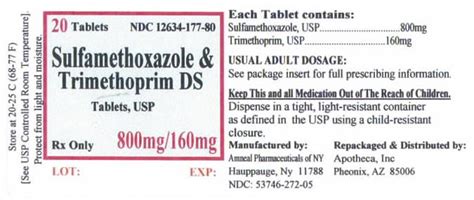Intro
Discover key facts about Sulfamethoxazole Trimethoprim, a potent antibiotic combo, including its uses, side effects, and interactions, to understand this prescription medications role in treating bacterial infections.
The importance of understanding antibiotics and their uses cannot be overstated, especially in today's world where antibiotic resistance is a growing concern. Among the many antibiotics available, Sulfamethoxazole Trimethoprim, also known as co-trimoxazole, stands out due to its broad spectrum of activity against various bacterial infections. This combination antibiotic has been widely used for decades, treating a range of infections from urinary tract infections to respiratory infections. Its effectiveness and the mechanisms by which it works make it a crucial component of modern medicine.
Sulfamethoxazole Trimethoprim is a combination of two antibiotics: sulfamethoxazole and trimethoprim. Each component works by inhibiting folic acid synthesis in bacteria, which is essential for bacterial growth and replication. This synergistic effect enhances the drug's efficacy, making it more effective than either component alone. The drug's ability to target a wide variety of bacterial infections, including those caused by both Gram-positive and Gram-negative bacteria, underscores its significance in clinical practice. However, like all antibiotics, its use must be judicious to combat the growing issue of antibiotic resistance.
The application of Sulfamethoxazole Trimethoprim extends across various medical specialties, including urology, pulmonology, and infectious diseases. Its role in treating uncomplicated urinary tract infections, as well as more severe infections like pneumonia, highlights its versatility. Moreover, in the context of HIV/AIDS, Sulfamethoxazole Trimethoprim is used for the prevention and treatment of pneumocystis pneumonia, a common opportunistic infection in individuals with compromised immune systems. Understanding the benefits, potential side effects, and proper use of this antibiotic is crucial for healthcare providers and patients alike, ensuring its continued effectiveness in combating bacterial infections.
Introduction to Sulfamethoxazole Trimethoprim

Benefits of Sulfamethoxazole Trimethoprim
The benefits of using Sulfamethoxazole Trimethoprim include its high efficacy rate, the convenience of twice-daily dosing for many infections, and its relatively low cost compared to other antibiotics. Additionally, its broad spectrum of activity means that it can be used to treat a variety of infections, reducing the need for multiple prescriptions or switching between different antibiotics.Working Mechanism of Sulfamethoxazole Trimethoprim

Steps for Taking Sulfamethoxazole Trimethoprim
When taking Sulfamethoxazole Trimethoprim, it is essential to follow the prescribed dosage and duration of treatment. The steps include: - Taking the medication with a full glass of water - Completing the full course of treatment, even if symptoms improve before finishing the medication - Informing your healthcare provider about any allergies or sensitivities - Monitoring for side effects and reporting them to your healthcare providerSide Effects and Precautions

Precautions for Use
Precautions for the use of Sulfamethoxazole Trimethoprim include: - Avoiding use in patients with known hypersensitivity to sulfonamides or trimethoprim - Using with caution in patients with kidney or liver disease - Monitoring for signs of kernicterus in newborns, as sulfonamides can displace bilirubin from plasma proteins - Advising patients to stay hydrated and to report any signs of kidney problemsPractical Examples and Statistical Data

Statistical Overview
A statistical overview of the use of Sulfamethoxazole Trimethoprim reveals: - High efficacy rates in treating urinary tract infections and respiratory infections - A broad spectrum of activity against both Gram-positive and Gram-negative bacteria - A relatively low rate of resistance development compared to other antibiotics - Cost-effectiveness, making it a preferred choice for many infectionsSEO Optimization and Readability

Readability Tips
Tips for improving readability include: - Using clear, simple language - Breaking up long paragraphs into shorter ones - Incorporating visual aids like images and diagrams - Providing summaries or overviews of complex informationEngagement and Call to Action

Call to Action
The call to action includes: - Sharing personal stories or experiences with Sulfamethoxazole Trimethoprim - Asking questions or seeking clarification on any points - Providing feedback on the article to help improve future content - Sharing the article on social media to promote awareness and educationWhat is Sulfamethoxazole Trimethoprim used for?
+Sulfamethoxazole Trimethoprim is used to treat a variety of bacterial infections, including urinary tract infections, respiratory infections, and skin infections.
How does Sulfamethoxazole Trimethoprim work?
+Sulfamethoxazole Trimethoprim works by inhibiting folic acid synthesis in bacteria, which is essential for bacterial growth and replication.
What are the common side effects of Sulfamethoxazole Trimethoprim?
+Common side effects include nausea, vomiting, diarrhea, and allergic reactions. More severe side effects can include Stevens-Johnson syndrome or toxic epidermal necrolysis.
In
